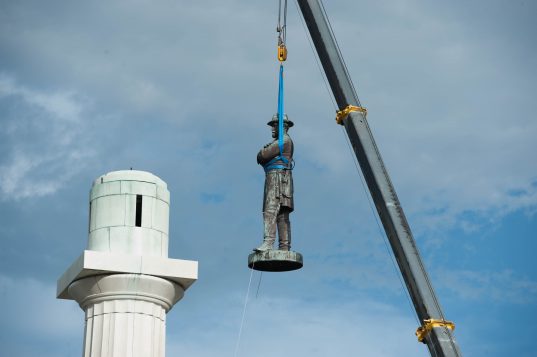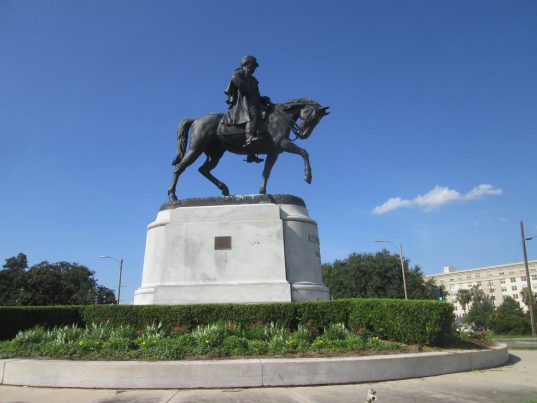New Orleans’ Confederate Monuments
 Robert E. Lee Monument Removal*
Robert E. Lee Monument Removal*
Mayor Mitch Landrieu of New Orleans gave a moving speech Friday afternoon, as the last of the city’s four Confederate monuments was coming down. He mentioned in his remarks that he’d been reminded, by one of the city’s most well-known sons and expats, of all the residents of the city who had left New Orleans because of exclusionary attitudes – people like my parents, and indeed much of my extended family, who joined the tens of thousands, and perhaps more, in leaving the city for a better life.
The formal public discussions regarding removal began two years ago – at a moment in history that seemed ripe for it. In June of 2015, a young white man walked into an historic black church in Charleston, South Carolina, sat in a Bible study to which he’d been welcomed by the church members, and at the end of the time, opened fire with an automatic weapon on the group, killing the pastor of the church along with eight parishioners. His stated motivation – to begin “a race war”.
The shooter escaped in a car bearing not only a South Carolina license plate, but also a three-flag “Confederate States of America” bumper decoration.
After that, discussions about removing the Confederate flag, which still flew over statehouses throughout the South, began anew throughout the region. Shortly after that, South Carolina removed the flag, its state legislature formally declaring that while the flag was “an integral part of our past, it does not represent the future”, laying the ground work for removal of other Confederate monuments.
The first of New Orleans’ statues to come down was an obelisk commemorating the Battle of Liberty place, an insurrection by the Crescent City White League, a paramilitary organization made up largely of Confederate veterans. Several on both sides of the fight died in the battle, including police officers, and many more were injured. The White League won that battle, and erected the monument in 1891, inscribing it with a plaque stating that the battle was fought for the “overthrow of carpetbag government” and that afterward the Yankees “recognized white supremacy in the South and gave us our state”. In 1989, the statue was moved from its position on Canal Street, the city’s main artery, to a less prominent location.
In 1993, the City Council voted to remove it entirely, taking it to a warehouse, but it was eventually reinstated. The inscription was covered with a new slab of granite, this one honoring “those Americans on both sides of the conflict who died,” and defining the battle as, “A conflict of the Past that should teach us lessons for the Future.”
When my brother, Eric, several years back, told my Uncle Paul that there was a monument to white supremacy in New Orleans, the city where he grew up and was married, Uncle Paul did not believe him. On his next visit, he sought it out, to see with his own eyes.
Its removal shouldn’t have been contested by any reasonable person.
The second and third monuments removed were statues of Jefferson Davis, President of the Confederacy, and General P.G.T. Beauregard, a native of coastal Louisiana who led Confederate troops.
 General Beauregard Statue**
General Beauregard Statue**
The first three statues were removed under cover of darkness, as there were death threats made against the contractors hired. One had his car set on fire and another backed out because of the threats. Workers wore masks and protective gear during the removal process.
No doubt, because of this, there was no advance warning when the first removal came, but after that, crowds waving Confederate flags and bearing guns – even automatic weapons, and mostly purported to have traveled from surrounding states, began gathering at the site of the Jefferson Davis statue. They were then countered by those in the city supporting the removal causing tension in the city.
When the time came, last Friday, for removing the last monument, a statue of Robert E. Lee, it was done in broad daylight, with a brass band (because it is New Orleans, after all) accompanying the feat. The statue was sixteen and a half feet tall and sat atop an almost 70 foot pedestal towering paternalistically (and make no mistake – its intent was to remind residents of just who was in charge) above the Central Business District of the city. The mayor’s speech came near the end of that day.
I have talked to people here – people I like and with whom I’m friendly, even who I consider fairly progressive, who’ve told me they think the statue removal is horrible. They say it’s about preserving history, and their Southern culture and heritage. When I questioned one of them further about it yesterday, he told me that’s what they’re taught all their lives growing up in Louisiana. He is Amerasian – half Burmese, and married to a Vietnamese woman. Does he imagine he has some protected status against white supremacists? One of the men wielding an automatic weapon at the protests at the Jeff Davis monument, and spouting off a similar line, was a very dark-skinned Indian. To hear him talk about protecting “his heritage” for his children and grandchidren was laughable to me.
History? Here’s my response. In his remarks, Mayor Landrieu also listed all the scores of various peoples and cultures that have contributed, over almost 300 years of its history, to this most unique of American cities. But there were 200 years of New Orleans history – and culture building – before those ever statues went up. And it mostly involved African and African descended people, enslaved and free, in what was then, and in large part remains, the most African city in the United States. I don’t see too many statues of them.
Parenthetically, I’d like to add, that Robert E. Lee and Jefferson Davis barely set foot in New Orleans. And that men like them were traitors to their country, and in many other countries, would have been executed at the end of the war, as was suggested by at least one Southern born Union general of the era***.
Yes, the statues themselves did have a certain amount of grace and beauty, but they stand for something very ugly in our history, and it is past time to let go of them. It’s time for us to embrace a more inclusive – and a more accurate, history – and to acknowledge that what we may have been taught has not served us well.
There has been some talk of hearings to discuss what should replace the statues, and already an impromptu piece of art has sprung up at the Jefferson Davis site, but as of yet, there have been no decisions for more permanent replacements.
As for me, I would like to see those African descended peoples, who created the cuisine, the music, and as Ms. Leah Chase reminded me a few years back, built the homes and created the intricate ironwork in this city’s historic buildings – that culture that people still flock to his city to enjoy – commemorated.
I implore you to listen to Mayor Landrieu’s speech.
* By Abdazizar (Own work) [CC BY-SA 4.0 (http://creativecommons.org/licenses/by-sa/4.0)], via Wikimedia Commons
** By Infrogmation (Own work) [CC BY-SA 4.0 (http://creativecommons.org/licenses/by-sa/4.0)], via Wikimedia Commons
*** “The greatest efforts made by the defeated insurgents since the close of the war have been to promulgate the idea that the cause of liberty, justice, humanity, equality, and all the calendar of the virtues of freedom, suffered violence and wrong when the effort for southern independence failed. This is, of course, intended as a species of political cant, whereby the crime of treason might be covered with a counterfeit varnish of patriotism, so that the precipitators of the rebellion might go down in history hand in hand with the defenders of the government, thus wiping out with their own hands their own stains; a species of self-forgiveness amazing in its effrontery, when it is considered that life and property—justly forfeited by the laws of the country, of war, and of nations, through the magnanimity of the government and people—was not exacted from them.”
— George Henry Thomas, November 1868






